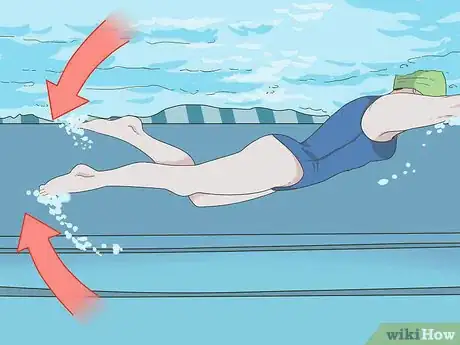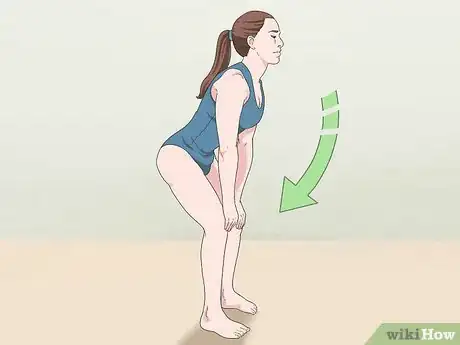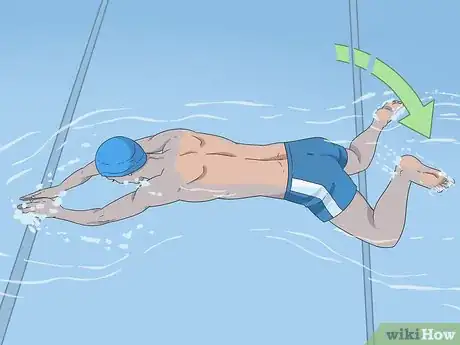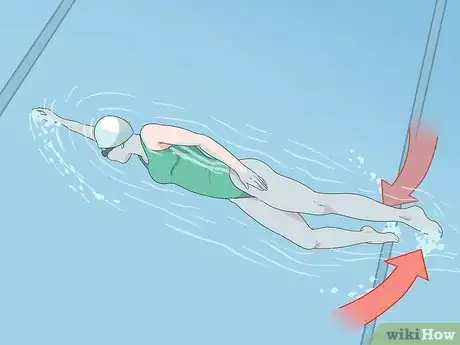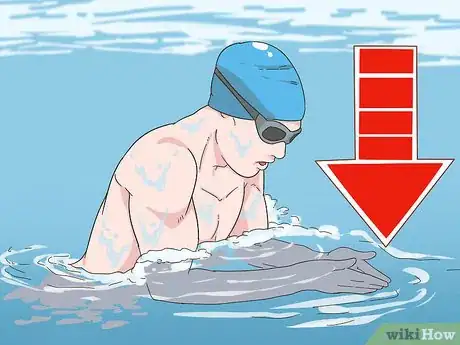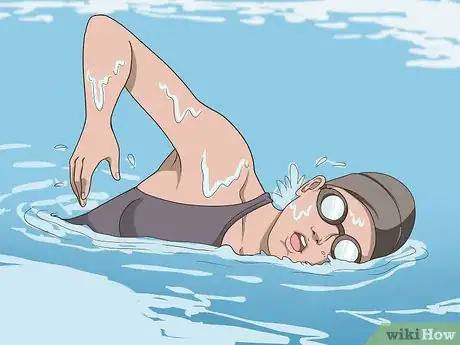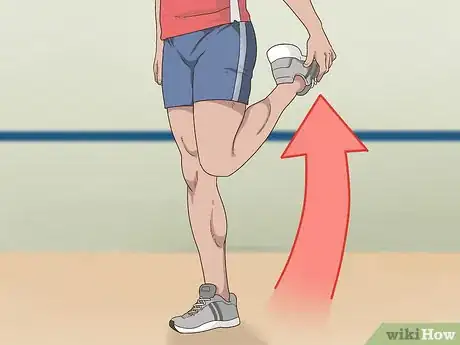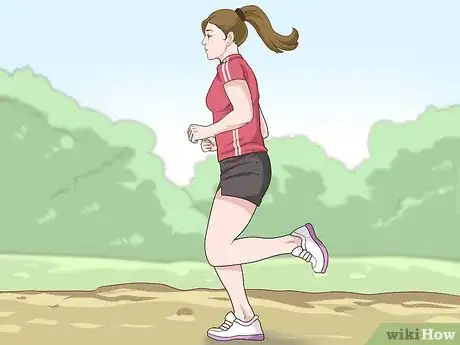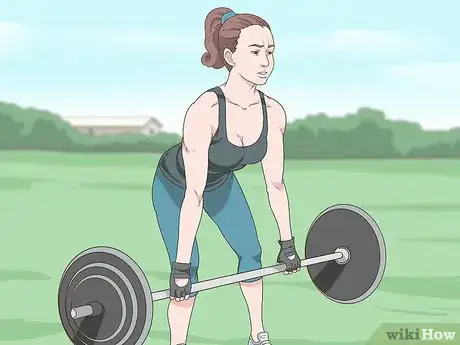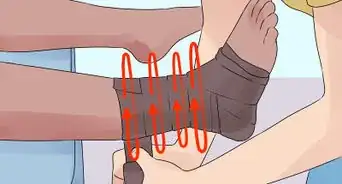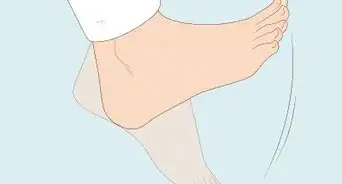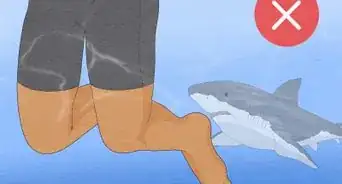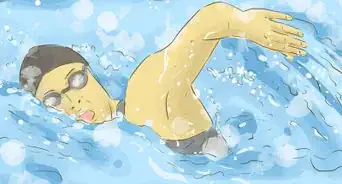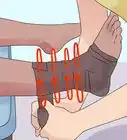wikiHow is a “wiki,” similar to Wikipedia, which means that many of our articles are co-written by multiple authors. To create this article, volunteer authors worked to edit and improve it over time.
This article has been viewed 25,516 times.
Learn more...
Breaststroke is one of the four widely known swimming styles. It is known for its harmonic movements and the anaerobic capacity it develops. In swimming, like in any other sport, there’s always a chance for injuries. Breaststrokers are known to develop knee problems, as the kick used in this style, requires the swimmer to push with a lot of strength at not usual angle. These injuries can become chronic when not treated appropriately. This article will show you how to prevent knee pain caused by breaststroke kick.
Steps
-
1Recognize your kind of kick, and pay attention to your technique. Based on the kind of competitive distance you are specialized, the width between the knees when doing the kick varies. Usually, sprinters tend to do their kick with their knees closer than mid-distance or IMers. This makes the angle of the knees with the ankles be more sharp, which at the end makes sprinters more likely for knee injuries. The most important thing is to make sure every kick is not out of the boundaries of the knee rotation, especially during the out sweep of the kick. Because most of the injuries happen, when swimmers do not pay close attention to their kick technique and end up making wrong movements while doing the kick.
-
2Warm up thoroughly before every swim practice or gym session. This is the key factor in avoiding knee injuries. Before getting in the water, do some joint movements. It’s always a good idea to start from your ankles up to your neck so you do not miss any part of your body. Dedicate some time to move your knees around. There are two basic movements:
- Stand up with your feet shoulder width apart and put your hands on your knees. bent them forward and return to initial position.
- Stand up with your feet shoulder width apart and put your hands on your knees. Bent them forward and then bring them a little to the outside almost in a circular way and then return to the initial position. Repeat the exercise bringing your knees to the opposite sense of the circular movement.
- It is also good for your body to get ready to go, to do around 10 minutes of aerobic, such as light rowing, jogging or jumping rope.
Advertisement -
3Warm up your knees in the water. Once you start your practice, make sure you do some laps in slow breaststroke, so your knees can get used to that movement. Inside your warm up, make sure you do some kicking; start slow, but as warm-up goes on you can accelerate your kick. A short kicking set during warm up is also a good idea.
-
4Kicking drills during warm-up. In order for you to improve the technique of your kick, preventing injuries, its necessary to perform drills that can make easier for you to execute the proper breaststroke kick for your type of stroke. Some of the most known drills are:
- 2-kicks-1-stroke: Make one complete breaststroke cycle and during the gliding part introduce a second kick and start again.[1]
- 1-kick-2-strokes: Make one complete breaststroke cycle and taking advantage of the momentum generated from the stroke, make another stroke without the kick and repeat.
- Kicking on your back: Lying on your back on a streamline position, go breaststroke kicking, trying to avoid that you knees come out too much out of the water and at the same time, trying to make sure the width between your knees does not exceed the usual one. This drill is especially good for swimmers that make the mistake of bringing their legs towards their chest when they kick.
- Kicking with hands your back: Lying on your belly, starting with your body completely flat in the water with your hands by the side of your legs, execute a breaststroke kick allowing your body to follow the undulation movement it produces, after the glide keep the kicks coming.
-
5Communication with your coach is a key part of your progress. As an athlete you must know that it’s different the way you perceive you are swimming and the way you look swimming; outside the water, the coach might be able to correct different aspects of your stroke. You should rely on your coach’s perspective and follow his advises during practice.
-
6Respect your limits. During long aerobic sets, while your knees are warm you might not feel pain as intense, but whenever you start feeling any kind of pain, you got to know when to stop. Sometimes pushing through the pain is not the best answer. Breaststroke is quite an anaerobic and high-impact stroke, and its common even for professional swimmers to do their long high aerobic sets in a different stroke, commonly freestyle.
-
7Warm-down enough. Almost as important as warming up, cooling down your muscles and joints plays a huge role in preventing injuries. It is very important for you as well to bring your heart rate down and allow your body’s temperature to go back to normal. Not cooling down after doing a tiring set can bring serious problems to your body, as it needs to remove all the lactic acid that your muscles developed while doing the practice set.
-
8Stretch after swimming. Stretching your legs after swim practice is one of the best ways to ensure an optimal and full recovery from the exercise done. Make sure you stretch the largest body muscles, such as your quads, gluteus, hamstrings and calves. There are several ways to stretch but here are some examples.
- To stretch your quads, stand up with your feet shoulder width apart, next to a wall or something you can rely on for support and bring one foot back to your gluteus and hold it with your hand. Leave your knees close to each other
- A more general stretch can be made by simply standing up with your feet together and incline your back towards the floor and try to touch your feet with your hands and your knees with your head.
-
9Commit inside and outside the pool. It is really important for you to pay attention to the activities you do outside of practice.
- Use proper shoes. They can be for running, training or even just for walking; you should always use some shoes that balance your feet and help your knees to stay in the right posture.
- Pay attention to the way you run and walk and make sure it is not affecting your knees. Try to always keep your knees with a slight bent.
- Follow a routine that suits your needs. Once you start getting used to protecting your knees daily it should start feeling like an unconscious act.
-
10Strengthen the muscles that surround your knee. There are plenty of exercises you can do to strengthen your leg muscles. Building strong muscles around your knee decrease the chance of injury. Even though, swimmers do most of their workout in the water, they also need to develop certain strength doing gym workouts or dry lands.
-
11Keep your body properly hydrated at all times. While doing intense workouts the muscles need to be at optimal conditions in order to work properly and prevent injuries. Your body requires the right kind of hydration, so it does not start cramping up in the middle of your practice. It’s important that you fuel your body after all the nutrients you lose in a high intensity workout. Many people underestimate the amount of effort involved with swimming, so remember, just because you do not see sweat doesn’t mean it’s not there.
-
12Be constantly active. Being healthy it’s not a one day thing, it’s a lifestyle. The risk of a knee injury decreases with people that are constantly active that has as well a healthy eating habit. If you have a healthy weight it’s less the weight your knees have to handle to your everyday activities. Find the balance in your routine in order to achieve a stable weight and a healthy nutrition.
References
- www.speedo.com
- https://www.youtube.com/user/ProTips4U
